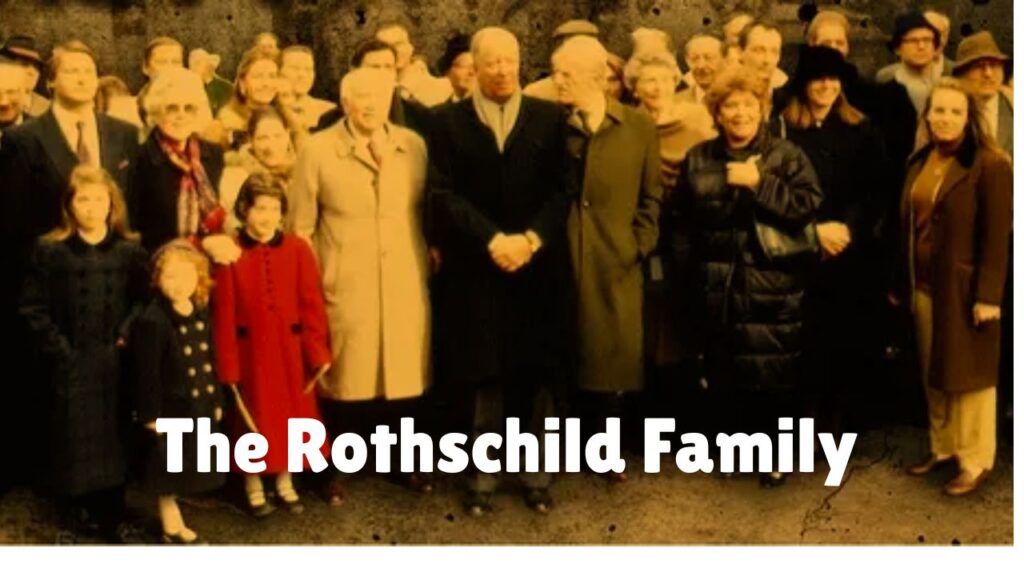The Rothschild Family is one of the most influential dynasties in world history, known for its unmatched success in banking, finance, and philanthropy. Originating from Frankfurt, Germany, in the late 18th century, Mayer Amschel Rothschild laid the foundation for what became a global financial empire.
His five sons established branches across Europe in London, Paris, Vienna, Naples, and Frankfurt creating the first international banking network. Their financial expertise, strategic vision, and family unity transformed the Rothschilds into symbols of power and wealth. Even today, their legacy continues through Rothschild & Co and their ongoing influence in global finance and culture.
Quick Summary
| Aspect | Details |
| Full Name | The Rothschild Family |
| Founded By | Mayer Amschel Rothschild (1744–1812) |
| Origin | Frankfurt, Germany – Judengasse (Jewish Quarter) |
| Founded In | Late 18th Century |
| Family Branches | London, Paris, Vienna, Naples, Frankfurt |
| Industry | Banking, Finance, Investment, Real Estate, Winemaking |
| Known For | Establishing one of the world’s most powerful banking dynasties |
| Peak Wealth Period | 19th Century (world’s largest private fortune) |
| Modern Successor | Rothschild & Co (global financial advisory firm) |
| Cultural Contributions | Art collections, architecture, vineyards, philanthropy |
| Notable Members | Mayer Amschel Rothschild, Nathan Mayer Rothschild, James Mayer de Rothschild, Jacob Rothschild |
| Headquarters (Today) | Paris & London |
| Legacy | Innovation in global finance, philanthropy, and cultural heritage |
| Controversies | Subject of antisemitic conspiracy theories (debunked by historians) |
| Motto / Principle | Unity, Trust, and Financial Vision Across Generations |
Origins and Early Years
The origins of the Rothschild family date back to the 15th century, in Frankfurt’s Jewish quarter known as the Judengasse. The family name “Rothschild” comes from the German term rothen Schild, meaning “red shield,” which once hung on their house.
In the 18th century, Mayer Amschel Rothschild (1744–1812) laid the foundation of the family empire. Initially a coin dealer and financial adviser, he developed close connections with royal clients and merchants. Through strategic networking and an exceptional grasp of finance, he became one of the most trusted bankers in Europe.
Mayer trained his five sons Amschel Mayer, Salomon Mayer, Nathan Mayer, Karl Mayer, and James Mayer and sent them across Europe to establish family branches in major cities. This vision transformed a small banking house into an international enterprise.
Rise of the Banking Empire

The five Rothschild brothers expanded operations to London, Paris, Vienna, Naples, and Frankfurt. Together, they created a web of finance that allowed for the rapid transfer of funds across borders, decades before telegraphs or international wire systems existed.
During the Napoleonic Wars (1803–1815), the Rothschild network played a crucial role in financing governments and moving funds securely across Europe. Their system became the backbone of international finance, and by the mid-19th century, the family had become one of the most influential financial forces in the world.
Peak Influence and Private Fortune
By the 19th century, the Rothschild family was at its peak. Their combined wealth was considered the largest private fortune in the world, exceeding that of any monarch or industrialist of the era.
The family financed some of Europe’s most important infrastructure projects, including railways, mines, and canals. They made pivotal loans to several governments most famously helping Britain purchase shares in the Suez Canal Company and assisting France with post-war reparations.
| Sector | Rothschild Involvement |
| Banking & Finance | Established cross-European network of family banks |
| Government Loans | Funded wars, indemnities, and infrastructure |
| Mining & Industry | Financed coal, steel, and oil ventures |
| Real Estate | Owned estates and palaces across Europe |
| Wine & Agriculture | Developed prestigious vineyards and estates |
Their influence extended beyond banking shaping European diplomacy, supporting technological progress, and driving industrial innovation.
Branches of the Family
Each branch of the family developed its own sphere of influence:
- British Branch – Founded by Nathan Mayer Rothschild (1777–1836) in London, known for financing Britain during wartime and establishing strong links with the Bank of England.
- French Branch – Led by James Mayer de Rothschild (1792–1868), who created one of Paris’s most powerful banking houses and supported large-scale infrastructure and cultural patronage.
- Austrian Branch – Founded by Salomon Mayer von Rothschild (1774–1855) in Vienna, influential in the Austrian Empire’s railways and mining sectors.
- Italian (Naples) Branch – Founded by Karl Mayer von Rothschild (1788–1855), serving the Italian aristocracy and Papal States.
Each branch shared information, capital, and trust a family-run multinational enterprise long before such corporations existed.
Modern Era and Business Evolution
As the world changed, so did the Rothschilds. In the 20th century, they transitioned from traditional banking to wealth management, asset management, and investment advisory services. Their companies gradually merged into the modern entity known as Rothschild & Co, headquartered in Paris and London.
Today, the family remains active in finance, real estate, agriculture, and renewable energy, emphasizing sustainability and long-term investment. Their discreet yet steady presence in the global financial sector showcases how legacy families adapt while maintaining influence.
Estates, Art Collections, and Winemaking
Beyond banking, the Rothschilds became patrons of art, architecture, and winemaking. Their estates such as those in England and France became cultural landmarks known for magnificent gardens and architecture.
The family also invested heavily in vineyards, giving rise to some of the world’s finest wines, including Château Lafite Rothschild and Château Mouton Rothschild. Their art collections include masterpieces that today reside in major museums and private galleries across Europe.
Succession, Inheritance, and Governance
For generations, the family followed strict traditions to preserve wealth. Marriages often occurred within the family to maintain financial unity a practice known as endogamy. Titles such as Baron and Freiherr were bestowed upon several members, cementing their noble status.
A structured system of family councils and private trusts governed business decisions. This careful planning ensured that despite wars, political changes, and market collapses, the Rothschilds maintained stability and continuity.
Controversies, Conspiracy Theories, and Antisemitism
The Rothschilds’ vast wealth made them targets of antisemitic conspiracy theories, many of which falsely claimed they controlled world finances or governments. These myths, rooted in prejudice, have persisted for centuries despite lacking factual basis.
In reality, the family’s influence stemmed from financial expertise, strategic partnerships, and disciplined investment, not secret manipulation. Historians regard them as pioneers of international banking not as the shadowy figures depicted in conspiracy circles.
Legacy and Relevance Today
The legacy of the Rothschild family extends far beyond finance. They influenced economic systems, philanthropy, education, science, and culture.
Their story highlights:
- How international cooperation built early globalization.
- How disciplined finance and family unity can preserve wealth across centuries.
- How philanthropy and cultural investment shape lasting social impact.
Today, the name “Rothschild” symbolizes sophistication, financial intelligence, and endurance. Their evolution from a 1760s coin business to a modern wealth management empire demonstrates the power of vision and adaptability.
Notable Family Members
- Mayer Amschel Rothschild (1744–1812) – Founder and patriarch who established the family’s financial base in Frankfurt.
- Nathan Mayer Rothschild (1777–1836) – Expanded the business to London and became one of Britain’s most influential financiers.
- James Mayer de Rothschild (1792–1868) – Head of the Paris branch, influential in railways and art patronage.
- Edmond James de Rothschild (1845–1934) – Philanthropist and supporter of Jewish settlement in Palestine.
- Jacob Rothschild, 4th Baron Rothschild (1936–2024) – Modern financier, art collector, and philanthropist who modernized the family’s legacy.
Legacy and Relevance Today
The Rothschild Family continues to influence the world through finance, art, and philanthropy. Modern descendants remain active in Rothschild & Co, global investment projects, and charitable foundations. Their enduring relevance lies in their adaptability transforming from traditional bankers to advisors in a digital, interconnected economy.
Their contributions to education, science, and culture further highlight their social impact. Above all, their story teaches that vision, structure, and unity can preserve legacy through centuries. From Frankfurt’s Judengasse to today’s boardrooms, the Rothschilds remain an enduring symbol of resilience, intellect, and innovation in global finance.
The Rothschild Family and Modern Banking Innovation
The Rothschilds introduced revolutionary systems that became the foundation of modern banking. Their innovations in international credit, secure fund transfers, and family-based networks allowed nations to move money across borders efficiently. They developed early forms of interbank communication using coded couriers and rapid intelligence, enabling them to anticipate market movements before competitors.
This foresight positioned them as Europe’s trusted bankers for centuries. Today’s financial institutions from investment banks to wealth management firms still apply models inspired by the Rothschild approach. Their financial innovation remains one of the most important legacies in global economics.
Philanthropy and Cultural Influence
Philanthropy has always been a cornerstone of the Rothschild identity. Members of the family have funded hospitals, universities, libraries, and museums across Europe. They supported the sciences through medical research, social welfare programs, and educational grants. Their patronage extended to art, music, and architecture, enriching Europe’s cultural landscape.
In the modern era, Rothschild foundations continue this legacy, supporting sustainable development and conservation projects worldwide. This deep sense of social responsibility shows that the family’s success was not just about accumulating wealth it was about using influence to uplift communities and preserve culture.
Lessons from the Rothschild Legacy
The Rothschild story offers timeless lessons for entrepreneurs and families alike. It demonstrates the power of longterm planning, trust-based partnerships, and adaptation to change. By combining innovation with strong values, the family achieved both prosperity and longevity.
Their model of dividing leadership while maintaining unity helped prevent internal conflict and ensured growth across generations. Modern family businesses can learn from their emphasis on education, discipline, and discreet influence. Ultimately, the Rothschild legacy is not just about wealth it’s about wisdom, structure, and the ability to evolve while remaining grounded in tradition.
Conclusion
The Rothschild Family’s journey from Frankfurt’s Judengasse to global prominence is a story of ambition, strategy, and legacy. They built one of history’s greatest banking empires, financed nations, and shaped the global economy. Despite myths and misconceptions, their influence is rooted in innovation, philanthropy, and enduring resilience.
Their name continues to represent excellence in finance and culture proof that visionary thinking, when paired with unity and adaptability, can create a legacy that lasts for centuries.
FAQs
Who were the Rothschild Family?
The Rothschild Family was a Jewish banking dynasty founded in Frankfurt during the 18th century by Mayer Amschel Rothschild. Through five sons who established branches across Europe, they built an international financial network that shaped global banking for centuries.
How did the Rothschild Family become rich?
They gained wealth through strategic government loans, industrial financing, and early international investments in railways, mining, and real estate. Their disciplined management and trans-European banking system turned them into one of history’s richest families.
What is Rothschild & Co today?
Rothschild & Co is the modern successor of the family’s banking houses. It operates as a global financial advisory firm offering services in wealth management, investment banking, and asset management, headquartered in Paris and London.
Did the Rothschilds really control world banking?
No. The idea that the Rothschilds secretly control global finance is a conspiracy theory. Historical evidence shows their influence came from legitimate innovation, expertise, and international cooperation in the 18th and 19th centuries.
What legacy did the Rothschilds leave behind?
Their legacy includes the foundations of modern finance, vast philanthropic work, contributions to art and culture, and a long-standing reputation for strategy, unity, and innovation in wealth preservation.
